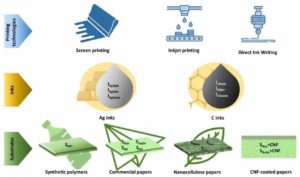The interest in the manufacture of electronic devices using printing techniques has been increasing in recent years due to the advantages it offers compared to classic microfabrication. These are better quality-cost ratio, more sustainability, lower energy consumption and material waste, and simpler manufacturing processes. Reserachers from the Biomedical Applications Group at the The Institute of Microelectronics of Barcelona (IMB-CNM, CSIC) have created a guide to promote the use of printed technologies.
The paper Experimental overview for green printed electronics: inks, substrates, and printing techniques, published in the Flexible and Printed Electronics journal, aims to improve decision-making on which printing technique, which ink and which substrate to use in order to facilitate the work of the scientific community.
 Our research team has compared the printing of test structures, optimizing the printing parameters and analyzing the results obtained. The variables studied are the flexibility and electrical properties of the printed layers, and the wettability, morphology and thermal stability of the substrates.
Our research team has compared the printing of test structures, optimizing the printing parameters and analyzing the results obtained. The variables studied are the flexibility and electrical properties of the printed layers, and the wettability, morphology and thermal stability of the substrates.
“We believe that this paper is important because it will facilitate the process of selecting materials and techniques by the community,” comments David Batet, pre-doctoral researcher at IMB-CNM and first author of the article. In addition, “due to the context of the environmental crisis and following the United Nations Sustainable Development Goals (SDGs), it is relevant to apply sustainability to all areas of society,” he adds and «this includes the fabrication of electronic devices and extending the use of sustainable printed electronics.”
Green printed electronics consist of using electronic printing techniques combined with the most sustainable inks and substrates depending on the type of electronic devices to be created, which, with current printing techniques, cannot be less than one micron in size. The devices that can be made are transistors, amperometric sensors, supercapacitors and batteries, antennas and solar cells, among other applications.
As Gemma Gabriel, IMB-CNM researcher and last author of the article, explains, «there are many applications where printed electronic materials and technologies are very useful.» Among them, she mentions «wearable electronics,” such as flexible and lightweight devices that can be integrated into clothing, accessories or directly on the skin; and “energy harvesting and storage,” such as lightweight and flexible energy harvesting devices, solar cells and thermoelectric generators. Moreover, the «Internet of Things (IoT),” with low-cost sensors easy to implement in smart home systems and industrial automation.
In addition, Gabriel highlighted the applications in health monitoring, «with non-invasive techniques such as glucose detection,» and in environmental monitoring, «in air and water quality control systems or detection of pollutants.”
For the research, the team has used the Unit 8 of the ICTS (Unique Scientific and Technical Infrastructure) NANBIOSIS of the Bioengineering, Biomaterials and Nanomedicine Networking Biomedical Research Centre (CIBER-BBN) at the IMB-CNM-CSIC and the MICRONANOFABS network, the ICTS of clean rooms for micro and nanofabrication in which the IMB-CNM-CSIC is integrated.
The research has been carried out within the ECOTRONIC projects, funded by the Ministry of Science and Innovation in the 2018 Innovation Challenges, and CEL-SENS, within the framework of the Strategic Projects Oriented to the Ecological Transition and the Digital Transition financed by the Ministry with funds from the European Union ‘NextGenerationEU’/Recovery, Transformation and Resilience Plan.
13/07/2023